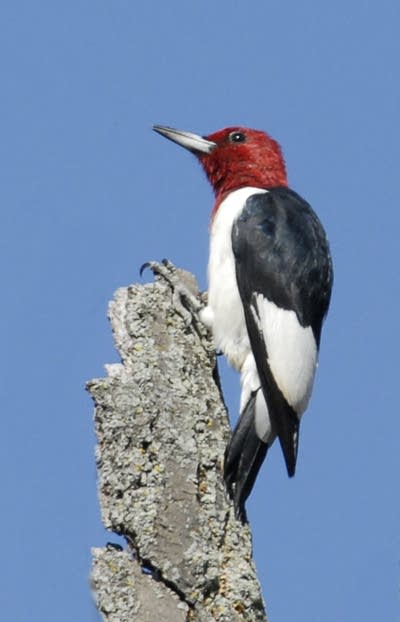'Save that snag' for red-headed woodpeckers
Go Deeper.
Create an account or log in to save stories.
Like this?
Thanks for liking this story! We have added it to a list of your favorite stories.

The Cedar Creek Ecosystem Science Reserve, run by the University of Minnesota, is a perfect place for red-headed woodpeckers. The landscape here is oak savannah with clumps of spreading oaks, separated by open areas carpeted with native grasses, shrubs and wildflowers.
This combination of trees and grasses once covered most of southern Minnesota. In those days, red-headed woodpeckers were all over the place.

You can't miss them: they're seven-to-nine inches long, with crimson heads, snowy white breasts, and long beaks.
Birder Lance Nelson first visited the Cedar Creek Reserve about a year ago.
Turn Up Your Support
MPR News helps you turn down the noise and build shared understanding. Turn up your support for this public resource and keep trusted journalism accessible to all.
"Somebody told me that there were red headed woodpeckers up here, so I came, walked five minutes, and there was a red-headed woodpecker," he says. "And it flew into a hole in a tree and I said, 'Wow, this is easy.'"
He came again this summer and found eight nests.
"The young make a lot of chattering, so you can usually tell where the nest is," Nelson says.
Today they're not hammering on trees -- the sound most of us associate with woodpeckers -- but they're doing plenty of chattering.
"There's a red-headed, and he's got a baby with him," whispers Chet Meyers. "God, they're beautiful. They are so beautiful."

Meyers retired as a professor at Metropolitan State University last year, and now he's in charge of an effort to make more places where red-headed woodpeckers can build their nests and raise their young.
They're starting here at the Cedar Creek Reserve because it's full of woodpeckers. There are about 50 of them in this 500-acre patch of ground.
If they can figure out exactly what the woodpeckers like so much about this place, maybe they can come close to reproducing the conditions elsewhere.
Chet Meyers is marking every tree where the woodpeckers have chosen to nest. He points out a cavity he noticed last time he was here.
"See these two trees to the left? Go to the right-most one, it forks, and there's a broken-off snag up there, looks like a "Y." That's where the babies were sticking their head out a couple weeks ago. It was really cute," he says.

Once the trees are marked, the group will catalog exact descriptions of each tree, in the hope of coming up with a profile of the perfect home for red-headed woodpeckers.
"We're going to measure the diameter of the tree, how high the nest cavity is, the species of the tree; is it alive or is it dead, so we can get some data on what seems to be the preferred habitat," says Meyers.
Then they'll reach out to land owners around the state to try to get them to leave standing dead and dying trees.
For people who worry that the tree will fall and damage something, Meyers says you can cut off the top and some of the bigger branches. The birds will be just as happy.
This could work on abandoned farms, where trees and grasses co-exist, he says. Or in cemeteries. Or around golf courses.

"If our theory -- see, this is all theory -- if our theory is correct, the golf course replicates an oak savannah and there should be birds there," Meyers says. "So, that's what we're hoping."
In fact, golf courses do tend to have red-headed woodpeckers. At the golf course at Ruttgers Bay Lake Lodge near Deerwood, several pairs are nesting in dead pines on the edge of the woods.
Meyers says helping woodpeckers means helping other creatures too.
"The woodpecker is called a primary nester, it digs the cavity. But flying squirrels, mice, snakes, bluebirds, tree swallows -- there are lots of other animals that are secondary nesters," Meyers says.

"They can't drill the hole. But they live there. So what we're trying to do is preserve the habitat so the woodpeckers drill the hole and when they leave, something else will come in and live in it."
Most red-headed woodpeckers leave Minnesota in the winter. But if there's enough food -- like the acorns at the Cedar Creek Reserve -- they'll stay through the winter. And that gives them a head start on raising their young in the spring.





